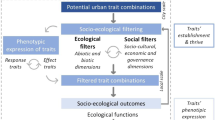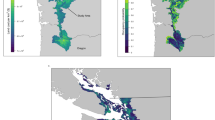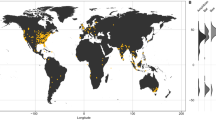Abstract
Cities are fully functioning ecosystems and are home to no-analogue communities of species that interact with each other and which are subject to novel urban stressors. As such, biodiversity can evolve in response to these new urban conditions, making urban species a moving target for conservation and management efforts. An evolving urban biodiversity necessitates integrating evolutionary insights into management for these efforts to be successful in a dynamic urban milieu. Here we present a framework for categorizing urban biodiversity from a management perspective. We then discuss a suite of example management tools and their potential evolutionary implications—both their opportunities for and potential consequence to management. Urban ecosystems are proliferating but, far from being ecological lost causes, they may provide unique insights and opportunities for biodiversity conservation. Determining how to achieve urban biodiversity priorities while managing pest species requires evolutionary thinking.
This is a preview of subscription content, access via your institution
Access options
Access Nature and 54 other Nature Portfolio journals
Get Nature+, our best-value online-access subscription
$29.99 / 30 days
cancel any time
Subscribe to this journal
Receive 12 digital issues and online access to articles
$119.00 per year
only $9.92 per issue
Buy this article
- Purchase on Springer Link
- Instant access to full article PDF
Prices may be subject to local taxes which are calculated during checkout

Similar content being viewed by others
References
Dearborn, D. C. & Kark, S. Motivations for conserving urban biodiversity. Conserv. Biol. 24, 432–449 (2009).
Shaffer, H. B. Urban biodiversity arks. Nat. Sustain. 1, 725–727 (2018).
Soanes, K. et al. Correcting common misconceptions to inspire conservation action in urban environments. Conserv. Biol. 33, 300–306 (2019).
Soanes, K. & Lentini, P. E. When cities are the last chance for saving species. Front. Ecol. Environ. 17, 225–231 (2019).
Donihue, C. M. & Lambert, M. R. Adaptive evolution in urban ecosystems. Ambio 44, 94–203 (2014).
Alberti, M. Eco-evolutionary dynamics in an urbanizing planet. Trends Ecol. Evol. 30, 114–126 (2015).
Rivkin, L. R. et al. A roadmap for urban evolutionary ecology. Evol. Appl. 12, 384–398 (2018).
Reid, N. M. et al. The genomic landscape of rapid repeated evolutionary adaptation to toxic pollution in wild fish. Science 354, 1305–1308 (2016).
Brans, K. I. et al. The heat is on: genetic adaptation to urbanization mediated by thermal tolerance and body size. Glob. Change Biol. 23, 5218–5227 (2017).
Brans, K. I. et al. Urbanization drives genetic differentiation in physiology and structures the evolution of pace-of-life syndromes in the water flea Daphnia magna. Proc. R. Soc. B 285, 20180169 (2018).
Diamond, S. E. et al. Evolution of plasticity in the city: urban acorn ants can better tolerate more rapid increases in environmental temperature. Conserv. Physiol. 6, coy030 (2018).
Diamond, S. E. et al. Evolution of thermal tolerance and its fitness consequences: parallel and non-parallel responses to urban heat islands across three cities. Proc. R. Soc. B 285, 20180036 (2018).
Cheptou, P.-O. et al. Rapid evolution of seed dispersal in an urban environment in the weed. Crepis sancta. Proc. Natl Acad. Sci. USA 105, 3796–3799 (2008).
Gorton, A. J. et al. Little plant, big city: a test of adaptation to urban environments in common ragweed (Ambrosia artemisiifolia). Proc. R. Soc. B 285, 20180968 (2018).
Kern, E. M. A. & Langerhans, R. B. Urbanization drives contemporary evolution in stream fish. Glob. Change Biol. 24, 3791–3802 (2018).
Schell, C. J. Urban evolutionary ecology and the potential benefits of implementing genomics. J. Hered. 109, 138–151 (2018).
De León, L. F. et al. Urbanization erodes niche segregation in Darwin’s finches. Evol. Appl. 12, 1329–1343 (2018).
Schilthuizen, M. Darwin Comes to Town: How the Urban Jungle Drives Evolution (Macmillan, 2018).
Koerner, B. I. How Cities Reshape the Evolutionary Path of Urban Wildlife (Wired, 2019).
Hendry, A. P. & Kinnison, M. T. The pace of modern life: measuring rates of contemporary microevolution. Evolution 53, 1637–1653 (1999).
Stockwell, C. A., Hendry, A. P. & Kinnison, M. T. Contemporary evolution meets conservation biology. Trends Ecol. Evol. 18, 94–101 (2003).
Li, E. et al. An urban biodiversity assessment framework that combines an urban habitat classification scheme and citizen science data. Front. Ecol. Evol. 7, 277 (2019).
Derry, A. M. et al. Conservation through the lens of (mal)adaptation: concepts and meta-analysis. Evol. Appl. 12, 1287–1304 (2019).
Urban, M. C., Tewksbury, J. J. & Sheldon, K. S. On a collision course: competition and dispersal differences create no-analogue communities and cause extinctions during climate change. Proc. R. Soc. B 279, 2072–2080 (2012).
Merilä, J. & Hendry, A. P. Climate Change, adaptation, and phenotypic plasticity: the problem and the evidence. Evol. Appl. 7, 1–14 (2014).
Alberti, M. et al. Global urban signatures of phenotypic change in animal and plant populations. Proc. Natl Acad. Sci. USA 114, 8951–8956 (2017).
Diamond, S. E., Chick, L., Perez, A., Strickler, S. A. & Martin, R. A. Rapid evolution of ant thermal tolerance across an urban-rural temperature cline. Biol. J. Linnean Soc. 121, 248–257 (2017).
Gould, S. J. & Lewontin, R. C. The spandrels of San Marco and the Panglossian paradigm: a critique of the adaptationist programme. Proc. R. Soc. B 205, 581–598 (1979).
Hendry, A. P. Key questions on the role of phenotypic plasticity in eco-evolutionary dynamics. J. Hered. 107, 25–41 (2016).
Littleford-Colquhoun, B. L., Clemente, C., Whiting, M. J., Ortiz-Barrientos, D. & Frere, C. H. Archipelagos of the Anthropocene: rapid and extensive differentiation of native terrestrial vertebrates in a single metropolis. Mol. Ecol. 26, 2466–2481 (2017).
Miles, L. S., Rivkin, L. R., Johnson, M. T. J., Munshi-South, J. & Verrelli, B. C. Gene flow and genetic drift in urban environments. Mol. Ecol. 28, 4138–4151 (2019).
Johnson, M. T. J. & Munshi-South, J. Evolution of life in urban environments. Science 358, eaam8327 (2017).
Munshi-South, J., Zolnik, C. P. & Harris, S. E. Population genomics of the Anthropocene: urbanization is negatively associated with genome-wide variation in white-footed mouse populations. Evol. Appl. 9, 546–564 (2016).
Combs, M. et al. Spatial population genomics of the brown rat (Rattus norvegicus) in New York City. Mol. Ecol. 27, 83–98 (2017).
Richardson, J. L. et al. Significant genetic impacts accompany an urban rat control campaign in Salvador, Brazil. Front. Ecol. Evol. 7, 115 (2019).
Combs, M., Byers, K., Himsworth, C. & Munshi-South, J. Harnessing population genetics for pest management: theory and application for urban rats. Hum.-Wildl. Interact. 13, 250–263 (2019).
Goddard, M. A., Dougill, A. J. & Benton, T. G. Scaling up from gardens: biodiversity conservation in urban environments. Trends Ecol. Evol. 25, 90–98 (2009).
Hostetler, M., Allen, W. & Meurk, C. Conserving urban biodiversity? Creating green infrastructure is only the first step. Landsc. Urban Plan. 100, 369–371 (2011).
Carlson, S. M. et al. Evolutionary rescue in a changing world. Trends Ecol. Evol. 29, 521–530 (2014).
Cook, C. N. & Sgrò, C. M. Poor understanding of evolutionary theory is a barrier to effective conservation management. Conserv. Lett. 12, e12619 (2018).
Piersma, T. & Drent, J. Phenotypic plasticity and the evolution of organismal design. Trends Ecol. Evol. 18, 228–233 (2003).
Martin, L. B., Ghalambor, C. K. & Woods, H. A. Integrative Organismal Biology (Wiley-Blackwell, 2015).
Brander, S. M., Biales, A. D. & Connon, R. E. The role of epigenomics in aquatic toxicology. Environ. Toxicol. Chem. 36, 2565–2573 (2017).
McNew, S. M. et al. Epigenetic variation between urban and rural populations of Darwin’s finches. BMC Evol. Biol. 17, 183 (2017).
Hale, R., Swearer, S. E., Sievers, M. & Coleman, R. Balancing biodiversity outcomes and pollution management in urban stormwater treatment wetlands. J. Environ. Man. 233, 302–307 (2019).
Gallagher, M. T. et al. The role of pollutant accumulation in determining the use of stormwater ponds by amphibians. Wetland Ecol. Man. 22, 551–564 (2014).
Brand, A., Snodgrass, J. W., Gallagher, M. T., Casey, R. E. & Van Meter, R. Lethal and sublethal effects of embryonic and larval exposure of Hyla versicolor to stormwater pond sediments. Arch. Environ. Contam. Toxicol. 58, 325–331 (2010).
Snodgrass, J. W., Casey, R. E., Joseph, D. & Simon, J. A. Microcosm investigations of stormwater pond sediment toxicity to embryonic and larval amphibians: variation in sensitivity among species. Environ. Pollut. 154, 291–297 (2008).
Simon, J. A., Snodgrass, J. W., Casey, R. E. & Sparling, D. W. Spatial correlates of amphibian use of constructed wetlands in an urban landscape. Landsc. Ecol. 24, 361–373 (2009).
Holzer, K. A. Amphibian use of constructed and remnant wetlands in an urban landscape. Urban Ecosyst. 17, 955–968 (2014).
Guderyahn, L. B., Smithers, A. P. & Mims, M. C. Assessing habitat requirements of pond-breeding amphibians in a highly urbanized landscape: implications for management. Urban Ecosyst. 19, 1801–1821 (2016).
Holtmann, L., Phillipp, K., Becke, C. & Fartmann, T. Effects of habitat and landscape quality on amphibian assemblages of urban stormwater ponds. Urban Ecosyst. 20, 1249–1259 (2017).
Miles, L. S., Johnson, J. C., Dyer, R. J. & Verrelli, B. C. Urbanization as a facilitator of gene flow in a human health pest. Mol. Ecol. 27, 3219–3230 (2018).
Miles, L. S., Dyer, R. J. & Verrelli, B. C. Urban hubs of connectivity, contrasting patterns of gene flow within and among cities in the western black widow spider. Proc. R. Soc. B 285, 20181224 (2018).
Shepack, A. et al. Species absence in developed landscapes: an experimental evaluation. Landsc. Ecol. 32, 609–615 (2017).
Acknowledgements
We thank B. Rosenblum, T. Jenkinson, O. Hernández-Gómez, M. Womack, M. Grundler, A. Rothstein, A. Byrne, K. Klonoski and C. Noss for providing critical feedback on this manuscript. The ideas in this manuscript benefited from conversations with M. Alberti, E. Carlen, S. Des Roches, K. Dyson, T. L. Fuentes, L. Guderyahn, G. B. Pauly, C. E. Santoro, C. J. Schell, O. J. Schmitz, H. B. Shaffer and I. Wang. We thank B. Verrelli for feedback that improved this manuscript.
Author information
Authors and Affiliations
Contributions
M.R.L. initiated the project. Both authors contributed to the writing and editing of the manuscript.
Corresponding author
Ethics declarations
Competing interests
The authors declare no competing interests.
Additional information
Publisher’s note Springer Nature remains neutral with regard to jurisdictional claims in published maps and institutional affiliations.
Rights and permissions
About this article
Cite this article
Lambert, M.R., Donihue, C.M. Urban biodiversity management using evolutionary tools. Nat Ecol Evol 4, 903–910 (2020). https://doi.org/10.1038/s41559-020-1193-7
Received:
Accepted:
Published:
Issue Date:
DOI: https://doi.org/10.1038/s41559-020-1193-7
This article is cited by
-
Effects of urban-induced mutations on ecology, evolution and health
Nature Ecology & Evolution (2024)
-
Smart phone-macro lens setup (SPMLS): a low-cost and portable photography device for amateur taxonomists, biodiversity researchers, and citizen enthusiasts
Bulletin of the National Research Centre (2023)
-
Urbanization and a green corridor do not impact genetic divergence in common milkweed (Asclepias syriaca L.)
Scientific Reports (2023)
-
The importance of urban areas in supporting vulnerable and endangered mammals
Urban Ecosystems (2023)
-
Home ranges of box turtles in a rural woodland and an urban park in Saint Louis, MO; implications for turtle conservation
Urban Ecosystems (2023)



